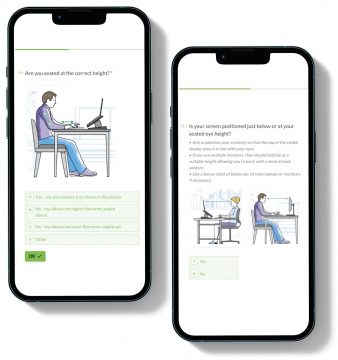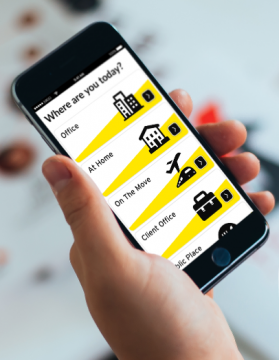Addressing the ergonomics of hybrid-working with e-Learning
We realised that our clients urgently needed a strategy to deliver DSE support to their now-remote workforce quickly in a way that would ensure their ...
The images of empty streets in 2020 are by now a distant memory. However, the coronavirus pandemic has changed the way we work, probably forever.
It’s been over four years since the first lockdown in the UK and hybrid, agile, remote working, whatever you call it, is here to stay and so is the support we provide.
Our clients needed a way to train employees on how to manage home working and assess employees home workstations, quickly and in large numbers. Many didn’t have a way to do this.

As our clients realised the benefits of home working, many employees remained working from home full time, but for some, hybrid working was introduced. Training and assessment was needed for both home and office working.
Some of our clients went one step further by extending hybrid working to ‘work anywhere’. They needed training and assessment support for employees working in a range of locations, including public places, when travelling, and at holiday homes.
And the shift to hybrid and working anywhere led to an increase in a global workforce, meaning English language or UK legislation based training and assessment programmes lacked relevance and compliance requirements for those working outside the UK.
We developed a comprehensive on-line risk assessment checklist that evaluates an employees’ working environment, setup, equipment/furniture used, and working practices.
Our assessment is fully customisable to reflect work locations (home/office/hybrid/remote), and can include our client’s logo or additional questions to address any specific requirements, as well as links to internal policies, guidance documents etc. Employees can quickly and easily access the customised assessment checklist via a link; they do not need to download any software applications.
For employees to carry out a self-assessment of their workstation, they must be provided with relevant information (to meet the requirements of The Health and Safety (Display Screen Equipment) Regulations 1992), including the risks associated with using DSE and how these can be controlled. For some clients, we include this as part of the introductory section of the on-line checklist or include a link e.g. to guidance on our client’s intranet.

We give information and advice relevant to each question. For example, if an employee’s feet were reported to not be fully supported on the floor when seated at the correct height, practical advice to obtain a footrest is immediately given. Our bespoke solutions include the employers process to arrange a footrest, such as an email address to place an order. And if an employee answers ‘no’ to ‘Do you take a 2-3-minute stretch/movement break away from your workstation every hour or so?’, a pop up window displays guidance on how posture breaks can be implemented throughout a working day.
Assessment results are reviewed and triaged by our ergonomics team. Based on employee responses, they provide tailored, individual advice to address outstanding issues or problems.
As home and hybrid working grew, we worked with our clients to create bespoke e-learning and assessment packages that truly reflected our client’s brand, language, imagery, hybrid working policy requirements and local legislation and guidance for those outside the UK.
We linked a calendar booking system into the process so anyone needing a remote consultation could book a time and date that was convenient to them.
We created reporting systems to deliver reports to clients on our work, assessment outcomes and recommendations made.
We also created an Ergonomics Companion App (available in Android and iOS versions) which can be branded and tailored to our clients’ work locations, preferences and corporate language. The App allows employees to quickly access ‘on the go’ ergonomics advice, based on where they are working.
Our client’s employees can access our training and assessment solutions quickly and easily. Assessments are accessed via a link that can be emailed or made available on our clients’ intranet site. There is no need to set up and remember log-in or password details.
Working closely with our clients to create bespoke, ‘on brand’ solutions, coupled with our ability to adapt and translate training and assessment solutions to reflect local legal or best practice guidance and languages has supported our client’s global workforces to implement ergonomic guidance to manage their comfort and wellbeing.
Our reporting system allows our clients to see assessment results in real time, monitor equipment requirements and gain valuable insights into common problems reported which require further investigation, for example poor office lighting or lack of awareness on corporate eye care processes.

Our remote consultations are quick and easy to set up through a simple online calendar booking system, reducing administration burden. Remote consultations carried out after successful completion of the training and assessment programme, means we take less time overall, making them budget friendly for you.

Or if you’d like to chat about how we can help you with a modern, bespoke and easy to use ergonomics training and assessment package, talk to Laura, our Head of Ergonomics.
We realised that our clients urgently needed a strategy to deliver DSE support to their now-remote workforce quickly in a way that would ensure their ...
Our tailored courses ensured the training was both engaging and relevant to the tasks performed at Bucher Municipal; including manual handling awkward...
BP (British Petroleum) is a global player in the oil and gas business. It engaged our ergonomics consultants to assist the company’s transition to a...